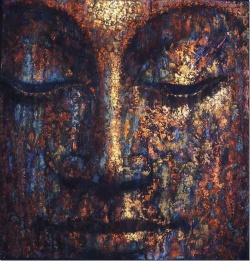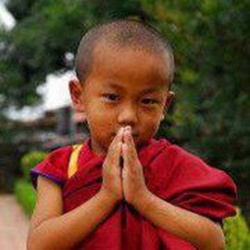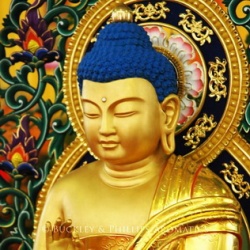Lama and Deity
Some advice from His Holiness Penor Rinpoche:
When the student’s attitude toward his or her lama is one of such faith and devotion that the student really sees the teacher as an actual Buddha, or as the very emodiment of the dharmakaya Vajradhara, or as the very embodiment of the student’s yidam – when the student has that kind of complete trust and faith, without any doubt, without hesitation – then the blessings and qualities of the enlightened form, speech and mind of all buddhas and bodhisattvas are transmitted through the lama to the student.
~~~
When it is a certainty in your mind that this is truly the Buddha, this is truly the dharmakaya Vajradhara, or that this is truly Guru Rinpoche that you are encountering and relying upon in your lama, and when you pray with that certainty in your mind, then you definitely receive the blessings from that connection. But this also implies that you, as a student, guard your own attitudes towards the teacher and ensure that you are always respectful and receptive to what the teacher is saying. Do not give in to your own ordinary habits of pride or self-aggrandizement or in any way undermine the relationship with the teacher by contradicting what the teacher says or by attempt to thwart the teacher’s efforts. Any and all of these attitudes are to be avoided since they do not support the trusting and open relationship that is necessary for the blessings to flow from the teacher to the student.
In the tantras it is stated again and again the importance of relying upon the lama as the source of blessings in one’s practice. Regardless of the particular prayer that the student offers to the lama, regardless of how small or seemingly insignificant it may be, if it is based upon the student’s complete trust and faith in the lama, then the blessings of the lama are always accessible to the student. In theTantra of the Ocean of Timeless Awareness, it states that it is far better to recite one small prayer to one’s lama out of pure faith and devotion than it is to perform hundreds of millions of recitations of deity mantras. The effect of prayer is far more powerful when it is truly an expression of one’s own faith and devotion in one’s lama.
When one has established a connection with one’s lama based upon trust, faith and devotion, there are different ways of relying upon that relationship through which various kinds of accomplishment can come about. If a student intends to attain the most sublime accomplishment of enlightenment itself, the student identifies the lama with Vajradhara – the dharmakaya buddha. If the student is particularly motivated to develop deeper wisdom, the student identifies the lama with Manjushri, the bodhisattva of wisdom. In order to encourage his or her own love and compassion, the student meditates upon the lama as inseparable from Avalokitesvara, the bodhisattva of compassion. To gain greater spiritual power the student focuses upon the lama as inseparable from Vajrapani, the bodhisattva of spiritual power. To overcome various kinds of fear and anxiety one relies upon the lama as the very embodiment of the venerable Tara. To promote one’s own longevity one meditates upon the lama inseparable from Amitayus. To overcome illness and disease one meditates upon the lama as the Medicine Buddha. To promote one’s own wealth and prosperity one meditates upon the lama as inseparable from Vaishravana, Jambhala, or any of the wealth deities. To purify the effects of harmful actions and to purify obscurations of one’s body, speech and mind, one meditates upon the lama as inseparable from the deity Vajrasattva. To increase one’s own personal glory, wealth and opportunity, one meditates upon the lama as inseparable from the Buddha Ratnasambhava, the buddha of the jewel family. To increase one’s power – one’s ability to exercise a powerful and beneficial influence over the world – one meditates upon the lama as inseparable from Amitabha or a deity such as Kurukulla. If one wishes to enact wrathful activity, one meditates upon the lama as inseparable from Vajrabhairava or any of the more wrathful yidams. If one wishes to adopt the approach that combines all of these qualities in a single form, one meditates upon one’s lama as inseparable from Guru Rinpoche. In each of these cases, one’s attitude is that of one’s own root lama being the very embodiment of one or another of these aspects of enlightened being.
~~~
When it comes to deity practice, we may find judgments arising in our mind saying, for example, that this deity is better that this deity, or this deity is more powerful than another deity, or this blessing comes more quickly with this deity. These types of ordinary thoughts are not really appropriate when we are dealing with something of this nature. The only qualifying factor is the devoted interest and faith in the student’s mind. It may be that under certain circumstances, your faith is stronger in a given deity and therefore that deity practice is more effective for you. But that does not mean that at a more ultimate level there is any distinction to made between these various aspects of enlightened being. They all arise from the single vast expanse of timeless awareness as equally authentic manifestations of blessing and power. There is no hierarchy, so to speak, among the deities. It is not the case that some are more powerful than others, or some more blessed than others, or some more productive of benefits than others. It is rather a question of the degree to which you as a practitioner are motivated in a given direction.
If you are concerned about the degree to which you are receiving blessings from your deity or from your practice, it would be far more useful to examine the degree to which you yourself are developing faith and devotion toward that yidam and toward your practice. The more our minds entertain doubt and anything other than a truly firm and lucid faith in our practice, that much are we confusing ourselves. We obscure our own minds with that doubt, vacillation and lack of certainty and trust. It is on that level that we can say there is no blessing in the practice. Not because the deity has no blessing. Not because the lama has no blessing. But because the student is closed to that blessing by his or her doubt and confusion.
~~~
The most important qualities to ensure the success of the (Guru Yoga) practice in the students’ mind are faith, devotion, trust and pure view. If a student is truly bent upon benefiting from his or her practice and his or her association with the dharma, those qualities are indispensable.


